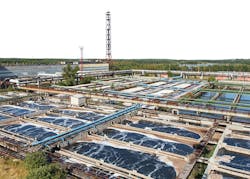Cellular-based wireless remote monitoring has seen greater market adoption in recent years as more process applications upgrade field technology and signal reliability becomes a non-issue. Leveraging remote data and Cloud platforms have led some companies to think beyond day-to-day hardware control to offer better visibility for their customers.
One company leading the charge toward Cloud as a platform is full-service systems integrator U.S. Water, based in St. Michael, Minn. The company offers integrated remote monitoring, chemical engineering and analytical services to many industries, including water and power utilities.
To improve operational efficiencies and visibility of plant data for its 5,000 customers, U.S. Water created a new networking solution leveraging cellular gateways. “Our goal was to streamline control of treatment programs, provide our customers with increased reliability, and include more data analysis for the field users,” says Michael Henk, strategic business leader, equipment service and automation, U.S. Water.
Before this modernization initiative, the company relied on regular plant operator site visits for measurements, chemical and equipment checks, and order deliveries. This manual process led to extended customer response times and high costs of doing business.
U.S. Water enlisted Minnetonka, Minn.-based Digi International to provide automation consulting services and equipment for an upgrade of its legacy offerings. U.S. Water added ConnectPort cellular routers to link to U.S. Water controllers at customer sites and pull in data from geographically dispersed water tanks via XBee ZigBee tank sensors.
This wireless solution provided U.S. Water a more efficient way to manage, control and update field equipment as needed. U.S. Water now can access tank level readings from multiple assets without having to run cables or power to widely distributed tanks.
Besides efficiency, the integrator can also provide more actionable data to its customers. Its U.S. Water Reports web-based application links field data to a document repository via the company’s office system, making data visible to customers with any web connection. The Water Reports tool includes technical data, material safety data sheets (MSDS) and inventory-related information.
“With the network expansion, our solution doesn’t just look at the unit operational data, but it links all the data that’s around a unit operation and out- side of it,” says Henk. “We can now aggregate all operational data in the Cloud and then we prioritize recommendations down to the engineers, field staff, and our customers can then implement those solutions, be it remotely or locally at that point.”
Supporting this system solution for U.S. Water is Device Cloud by Etherios, a division of Digi International. The Cloud platform enables more remote field devices to be managed and offers developers flexibility for different customers. “Device Cloud supports firmware updates as well as management of the file system for connected devices. This enables developers to load their own custom code onto each gateway under management in their Device Cloud account,” says Chuck Malone, Etherios director of marketing. This customization is important as U.S. Water serves many industries, including healthcare and commercial facilities.
For water treatment plants, U.S. Water now has a direct link to equipment, as well as insight into customers’ use of chemicals. The technology has helped U.S. Water create supply chain efficiencies and reduce transportation costs for field technicians, since there are fewer truck rolls and technicians on the road. Also, the integrator is now able to offer monitoring services to customers, freeing up customers’ time to focus on their core competencies.
The system’s monitoring features include customized key performance indicators (KPIs) pushed to dashboards via email. The email could contain just a single KPI, a group of KPIs or any other data specific to the condition being monitored, Henk says.
With any wireless plant application, network security is a concern. U.S. Water’s business model adds a layer of security by leveraging its own network backbone for data monitoring. “In most cases U.S. Water is operating on its local network for clients, so the risk usually doesn’t extend into our customers’ IT security policies,” Henk says.
The Device Cloud platform is ISO- 27001 certified and it offers controls for many frameworks, including HIPAA, SSAE 16, PCI-DSS and NERC-CIP. It also can be configured to ensure that no device connects using encrypted TCP.
“With the system in place, we provide a higher level of customer service, while freeing up our field engineers’ time so they can focus on higher-value tasks,” says Henk. “We’ve experienced direct increases in customer retention, corporate sales and pull-through revenue streams as a result of the remote automation solution.“

